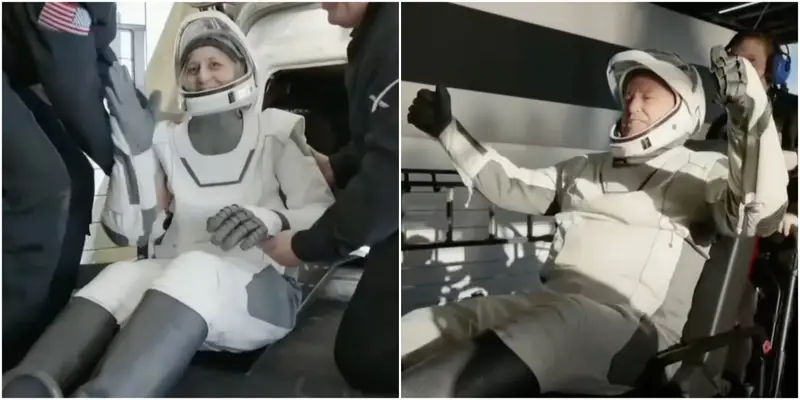NASA astronauts Butch Wilmore and Suni Williams have finally returned to Earth after an unplanned nine-month stay aboard the International Space Station (ISS).
Their journey concluded at 5:57 p.m. EDT when their SpaceX Crew-9 capsule splashed down off the coast of Florida, marking the end of a 286-day mission initially expected to last only eight days.
The capsule made a fast and fiery re-entry through Earth’s atmosphere, deploying four parachutes to slow its descent before gently landing in the Gulf of Mexico near Tallahassee. As recovery teams arrived, a pod of dolphins circled the craft, a rare sight that added to the spectacle.
NASA officials were quick to celebrate the return. Joel Montalbano, deputy associate administrator of NASA’s Space Operations Mission Directorate, commented:
“It is awesome to have Crew-9 home, just a beautiful landing.”
Wilmore, 62, and Williams, 59, were originally part of Boeing’s Starliner test flight, launched on June 5, 2024. However, the Starliner spacecraft suffered multiple technical failures, leading NASA to decide that bringing it back with the astronauts onboard was too risky.
By September 2024, the faulty Starliner was returned to Earth empty, leaving Wilmore and Williams without a ride home. NASA then arranged for their return on the next available SpaceX flight, but due to SpaceX’s mission schedule, this was delayed until March 2025.
Despite being described as “stranded,” NASA assured the public that emergency evacuation options were always available.
The astronauts made the best of their extended stay, conducting scientific experiments and spacewalks.
Suni Williams also set a new record for the most time spent spacewalking by a female astronaut—62 hours across nine spacewalks.
Elon Musk, Political Controversy, and Trump’s Intervention
The extended stay of Wilmore and Williams became a topic of political debate in January 2025, when former President Donald Trump criticized the Biden administration for delaying their return.
He publicly urged SpaceX CEO Elon Musk to speed up their retrieval.
“We are working as fast as possible,” Musk responded on his platform X (formerly Twitter), later congratulating the astronauts and NASA’s partnership with SpaceX on their successful return.
NASA officials, however, denied that politics played a role in the mission’s timeline. Steve Stich, NASA’s Commercial Crew Program Manager, said that safety was the top priority:
“This has been nine months in the making, and I couldn’t be prouder of our team’s versatility, our team’s ability to adapt and really build for the future of human spaceflight.”
Their Current Condition
After a 17-hour journey from the ISS, the astronauts were assisted out of the capsule and placed on reclining stretchers, a standard practice for returning astronauts who need time to readjust to Earth’s gravity.
Medical teams immediately checked their vitals and were flown to NASA’s Johnson Space Center in Houston, Texas, where further health evaluations will be conducted.
According to British astronaut Tim Peake, who spoke with BBC News, the re-adjustment process can be difficult:
“Those first two or three days back on Earth can be really punishing.”
Williams, in an interview with CBS just last month, expressed excitement about simple pleasures:
“I’m looking forward to seeing my family, my dogs, and jumping in the ocean. That will be really nice—to be back on Earth and feel Earth.”
Wilmore, a father of two, missed a good part of his younger daughter’s senior year of high school, while Williams had to rely on internet calls to keep in touch with her husband and mother.
Across the U.S., supporters celebrated their safe return. At least 21 Hindu temples prayed for Williams, whose father’s family originates from Jhulasan, India. Upon hearing of her safe landing, the town held festive dances and religious rituals while Wilmore’s Baptist church in Houston prayed for his return.
What’s Next?
NASA plans to continue evaluating the Starliner program before deciding whether Boeing or SpaceX will handle upcoming flights.
Meanwhile, Wilmore and Williams will undergo months of physical rehabilitation to regain muscle strength and adapt to Earth’s gravity.
The two astronauts are finally home after 286 days in space, 4,576 Earth orbits and 121 million miles traveled.



